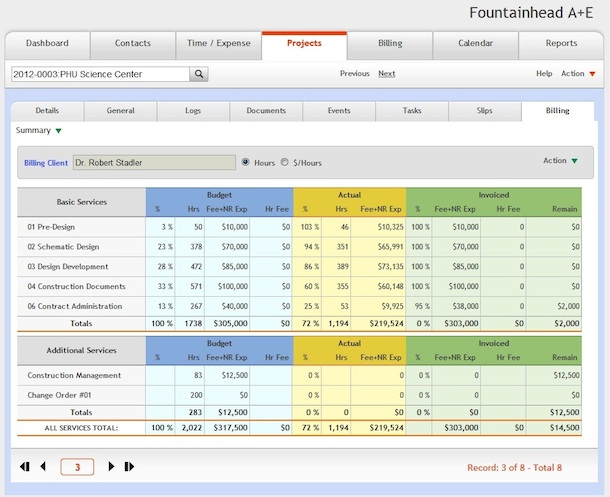They started with just 2 employees and a big dream—to be a premier high-end, multidisciplinary firm, able to provide clients with a full range of services. They wanted to meet and exceed the most discerning clients’ expectations and have Vertical Arts’ vision stamped on every aspect of production.
Since Vertical Arts opened its doors in ’05, they’ve been using ArchiOffice to handle billing and project management. They had fluctuations like everyone else during the roughest years of the recession, yet they’ve more than quadrupled their staff and have plans to expand even more in the coming years.
Their revenue has gone up 300-350% in eight years’ time. Their accountant has even started recommending ArchiOffice to neighboring firms.
They’re able to offer a full service architectural experience—coordinating surveyors, helping clients orchestrate moves or get home inspections done, and allowing consultant billing to come through them.
How Do They Do It?
They Invoice in Half a Day or So
Using ArchiOffice means they can get billing done for all their complex projects in half a day to a day. So all employees’ hours are always billable, and Parker, the company’s only administrative employee can tackle billing efficiently, getting on to his other responsibilities. “If we didn’t have ArchiOffice, we’d have to hire at least one more person, part or full time,” he admits. Instead, they can take on more jobs and projects because their staff isn’t tied up doing administrative work.
They Organize Projects Ridiculously Well
Parker explains: “We have one specific project that we’ve chosen to divide into with 9 sub-projects, so that we can individually track time and expense per sub-project. And ArchiOffice keeps that whole world organized for us. ArchiOffice allows us to manage more jobs and projects with still just one support staff member.”

Since Vertical Arts opened its doors, the firm has been using ArchiOffice to handle billing and project management. The firm can get billing done for their projects in less than a day.
Their Client Relationships are Rock Solid
“It streamlines our process and gives us access to tons of information and reports quickly so we don’t spend much time answering questions for clients—we just generate it and send it right back. I know our clients trust our billing and our process. It’s really strengthened our client relationships.”
They Became an Incredibly Impressive Firm
“Overall ArchiOffice is just a great billing and project management software—to be able to go to one place and see all your time, all your budgets, all your invoices and transactions, it just streamlines the administrative side significantly,” explains Parker.
Now, Vertical Arts doesn’t have to settle for taking on uninspiring projects. They do most of their work with a number of individual clients. They’ve achieved their dream of being a multidisciplinary high-end firm—they have an interior designer on staff, a landscape architect, as well as a full architectural team, so they’re able to provide the full range of services they know their clients deserve.
Learn more about ArchiOffice Software here.
Check out Vertical Arts Architecture here.
Related Stories
Contractors | Aug 1, 2024
Nonresidential construction spending decreased 0.2% in June
National nonresidential construction spending declined 0.2% in June, according to an Associated Builders and Contractors analysis of data published today by the U.S. Census Bureau. On a seasonally adjusted annualized basis, nonresidential spending totaled $1.21 trillion. Nonresidential construction has expanded 5.3% from a year ago.
Student Housing | Jul 31, 2024
The University of Michigan addresses a decades-long student housing shortage with a new housing-dining facility
The University of Michigan has faced a decades-long shortage of on-campus student housing. In a couple of years, the situation should significantly improve with the addition of a new residential community on Central Campus in Ann Arbor, Mich. The University of Michigan has engaged American Campus Communities in a public-private partnership to lead the development of the environmentally sustainable living-learning student community.
MFPRO+ New Projects | Jul 31, 2024
Shipping containers converted into attractive, affordable multifamily housing in L.A.
In the Watts neighborhood in Los Angeles, a new affordable multifamily housing project using shipping containers resulted in 24 micro-units for formerly unhoused residents. The containers were acquired from a nearby port and converted into housing units at a factory.
Adaptive Reuse | Jul 30, 2024
Empty mall to be converted to UCLA Research Park
UCLA recently acquired a former mall that it will convert into the UCLA Research Park that will house the California Institute for Immunology and Immunotherapy at UCLA and the UCLA Center for Quantum Science and Engineering, as well as programs across other disciplines. The 700,000-sf property, formerly the Westside Pavilion shopping mall, is two miles from the university’s main Westwood campus. Google, which previously leased part of the property, helped enable and support UCLA’s acquisition.
Geothermal Technology | Jul 29, 2024
Rochester, Minn., plans extensive geothermal network
The city of Rochester, Minn., home of the famed Mayo Clinic, is going big on geothermal networks. The city is constructing Thermal Energy Networks (TENs) that consist of ambient pipe loops connecting multiple buildings and delivering thermal heating and cooling energy via water-source heat pumps.
High-rise Construction | Jul 29, 2024
Safdie Architects’ Shanghai office tower features glass-enclosed corner garden that ascends the 35-story structure
Safdie Architects has announced the completion of LuOne Mixed-Use Complex—a business, retail, and entertainment development in the Luwan district of Shanghai, China. The mixed-use complex consists of an eight-level retail galleria, which opened in 2018, and a 35-story office tower, which recently reached completion.
Designers | Jul 29, 2024
Inclusive design for locker rooms: Providing equitable choice and access
SRG designers pose the question: What would it look like if everyone who wanted to use a restroom or locker room could?
Casinos | Jul 26, 2024
New luxury resort casino will be regional draw for Shreveport, Louisiana area
Live! Casino & Hotel Louisiana, the first land-based casino in the Shreveport-Bossier market, recently topped off. The $270+ project will serve as a regional destination for world-class gaming, dining, entertainment, and hotel amenities.
Smart Buildings | Jul 25, 2024
A Swiss startup devises an intelligent photovoltaic façade that tracks and moves with the sun
Zurich Soft Robotics says Solskin can reduce building energy consumption by up to 80% while producing up to 40% more electricity than comparable façade systems.
Codes and Standards | Jul 25, 2024
GSA and DOE select technologies to evaluate for commercial building decarbonization
The General Services Administration and the U.S. Department of Energy have selected 17 innovative building technologies to evaluate in real-world settings throughout GSA’s real estate portfolio.

















